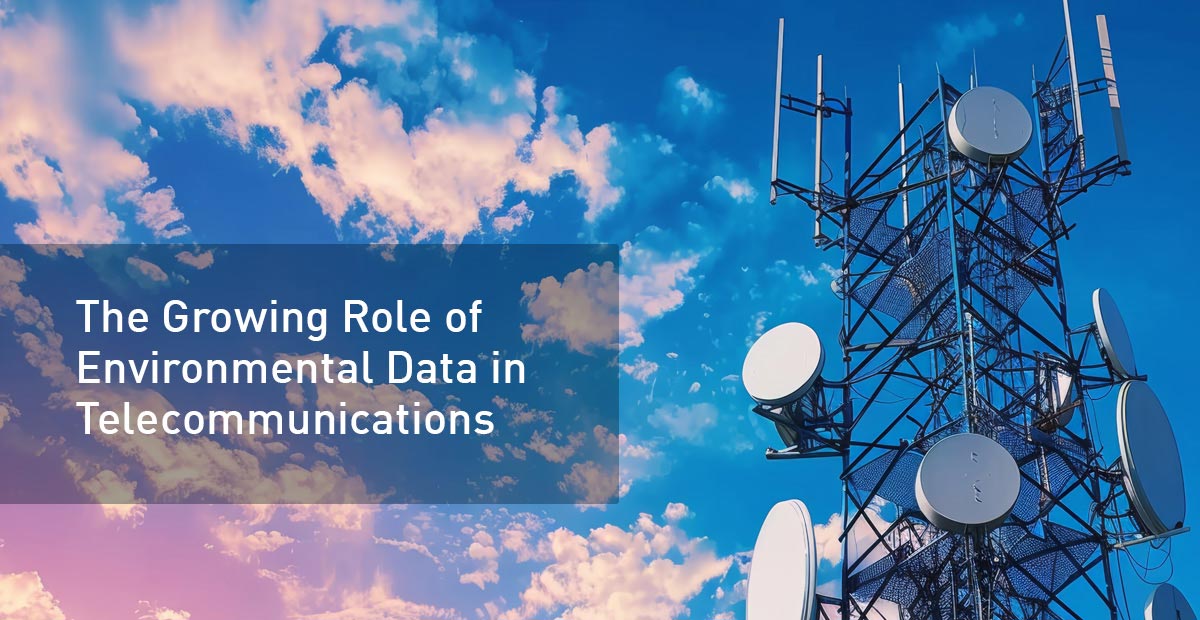The Growing Role of Environmental Data in Telecommunications
Article
Is the telecommunications industry paving the way for a greener future, or are they just another cog in the environmental crisis machine?
It’s an obvious observation to say our lives are increasingly intertwined with digital connectivity. The growth of telecommunications networks is nothing short of a modern “gold rush.” As top industry brands race to blanket the nation with a faster, more reliable network, a critical question has emerged: What is the cost to our environment? The environmental footprint of these looming infrastructures such as cell towers, data centers, and endless miles of fiber-optic cables can be vast, yet often flying under the radar. With climate change more erratic than ever, how we build these networks today will define the environmental legacy we leave for future generations.
Environmental data is the unsung hero in this high-stakes game of Risk. It’s no longer just about finding the most cost-effective or logistically convenient site; it’s about making decisions that harmonize this advancing technological industry with environmental stewardship. This isn’t just a matter of corporate responsibility, it’s about survival in an age of escalating climate crises and tightening regulations. The real challenge lies in harnessing the power of environmental data to not only mitigate harm but to actively drive the telecommunications industry towards better sustainability and decision making. The game has started, and the question is whether the telecom industry can adapt fast enough to win it.
As the telecommunications industry expands its footprint across the United States, three critical phases of development emerge as battlegrounds for environmental sustainability: site selection, site development, and ongoing operational sustainability. These aren’t just technical steps in a construction process; they’re pivotal moments where their decisions can influence the protection or harm of our planet. In each step, the use of environmental data is proving to be a game-changer, offering a path of reconciliation to the industry’s relentless growth, highlighting an urgent need to safeguard our environment.
The choice of where to place new infrastructure can set the tone for the entire lifecycle of a telecommunications project. By integrating environmental data early on, companies can avoid ecologically sensitive areas, reduce their carbon footprint, and ensure compliance with strict regulations. With significant numbers of U.S. telecom companies prioritizing sustainability in their site selection process–are these efforts enough to meet the environmental challenges of our time?
Site Selection: The First Line of Defense
Where telecom players choose to plant their infrastructure isn’t just a logistical decision—it’s an environmental one. Site selection sets the tone for how sustainable a project can be from the get-go. In recent years, the use of environmental data has been critical for telecom companies in the United States, enabling them to make informed decisions that minimize ecological disruption and enhance resilience against natural disasters.
- Environmental Considerations at the Forefront: In 2022, 68% of U.S. telecommunications companies were already factoring Environmental, Social, and Governance (ESG) concerns into their site selection process, with expectations that this number will continue to climb through 20241. This signifies a growing recognition that the environmental footprint of telecom infrastructure can no longer be an afterthought.
- Mitigating Natural Disaster Risks: The importance of climate risk assessments has skyrocketed, with 74% of companies incorporating these evaluations into their site selection criteria in 20221. This figure is proposed to rise to 80% through 2024, reflecting the increasing frequency and severity of natural disasters. Companies are turning to environmental data to steer clear of flood zones, hurricane paths, and other high-risk areas, ensuring their networks remain robust and reliable in the face of nature’s unpredictability.
- Embracing Renewable Energy: The integration of renewable energy into site selection has also gained momentum. In 2022, 57% of new telecom sites were chosen based on their potential for incorporating solar or wind power, a figure expected to reach 75% in 20241. This proactive approach not only reduces long-term operational costs but also aligns with broader sustainability goals, proving that the future of telecommunications is, quite literally, being powered by the sun and wind.
Environmental data has become a cornerstone in the strategic decision-making process for site selection in the telecom industry. By leveraging up-to-date environmental insights, companies can zone in on locations that not only support optimized network performance but also align with sustainability goals and regulatory requirements. This data-driven approach allows telecom companies to look at a variety of factors before breaking ground.
Climate data plays a pivotal role in identifying areas that are less prone to natural disasters like floods or wildfires, which could jeopardize the integrity of telecommunications infrastructure. By analyzing climate risk data and projections, companies can avoid high-risk zones, thereby enhancing the resilience of their networks. Furthermore, environmental assessments are utilized to gauge the potential impact on local ecosystems, ensuring that the development does not disrupt wildlife habitats, degrade natural resources, enter areas with possible contamination, or conflict with regulations. This helps in securing the necessary regulatory approvals but also fosters positive community relations by demonstrating environmental commitment.
Additionally, the integration of Geographic Information Systems (GIS) let companies overlay environmental data with other critical metrics, such as FEMA data and land use, to select sites that maximize coverage while minimizing environmental impact. This holistic view ensures chosen locations are not only viable for technical and operational needs but also provide long-term sustainability. The role of environmental data in site selection is not just a trend—it’s an expectation, paving the way for a greener, more resilient infrastructure.
Site Development: Building with the Environment in Mind
Once the ideal site has been selected, the next phase is site development, where the integration of environmental data continues to play a key role. This stage offers telecom companies the opportunity to implement practices that will shape the environmental footprint of the infrastructure for years and years. The decisions made during site development are important, as they determine not only the operational efficiency of the site but also its long-term sustainability and compliance with environmental regulations.
- Green Building and Waste Reduction: In 2023, 70% of mobile network operators globally, including those in the U.S., committed to or were in the process of implementing green building certifications, such as LEED, in their site development projects2. This commitment shows the industry’s growing focus on reducing the environmental impact of new infrastructure.
- Energy Management Systems: Environmental data has been instrumental in guiding adoption of energy management. By end of 2024, it is expected that majority of U.S. telecommunications companies will integrate these systems into their development processes, allowing for real-time monitoring and optimization of energy use, thereby reducing both waste and costs.
- Renewable Energy Integration: The move towards renewable energy solutions in site development continues gaining momentum. 65% of U.S. telecom sites are projected to incorporate solar or wind power in 2024, driven by environmental data that optimizes the placement and effectiveness of these systems3. This aligns with sustainability goals and also helps mitigate the volatility of energy costs.
The use of environmental data during site development is pivotal to ensure telecommunications infrastructure are built to be sustainable and regulatory compliant from the ground up. By incorporating environmental assessments into the planning and construction phases, telecom companies can significantly reduce environmental impact and enhance the overall efficiency of their operations.
Site development is thus multifaceted, and environmental data can influence everything from the choice of materials to the design of operational systems. By embedding sustainability into the development process, telecom companies are not only meeting the demands of today but also future-proofing infrastructure against the environmental challenges of tomorrow.
Sustainability: Ensuring Long-Term Environmental Stewardship
Sustainability in the telecom industry is not just about choosing the right site or implementing green building practices, it’s about maintaining and improving environmental performance. As telecommunication infrastructures become more integral to our lives, the industry’s responsibility to the environment grows. Continuing the use of environmental data helps guarantee infrastructures not only meet today’s standards but are prepared for future environmental challenges.
- Ongoing Energy Efficiency: Sustainability is a significant focus. Efforts are on reducing the energy consumption of telecom infrastructure. In 2023, 75% of U.S. telecom companies implemented energy-efficient technologies in their operations, a figure expected to rise to 85% in 20244. These technologies, driven by real-time environmental data, help reduce the carbon footprint of telecommunications networks while lowering operational costs.
- Circular Economy Initiatives: In an effort to minimize waste, many U.S. telecom companies are adopting circular economy practices. In 2023, 65% of telecom companies in the U.S. had established recycling programs for network equipment and other materials. This initiative is projected to expand as companies increasingly recognize the economic and environmental benefits of reducing waste and reusing materials5.
- Carbon Footprint Reduction: Sustainability efforts also focus on reducing overall carbon emissions. At the end of 2023, 68% of new telecom sites in the U.S. were designed with the goal of achieving a 30% reduction in carbon emissions. This figure is expected to increase through 2024 as companies continue to refine their use of environmental data to identify opportunities for further reductions6.
This highlights the industry’s commitment to sustainability, driven by environmental data and a growing recognition of environmental responsibility. The real challenge, however, lies in maintaining and enhancing these initiatives as the industry continues growing. Environmental data is crucial in ensuring that sustainability efforts in the telecom industry is a long-term strategy. Accurate data helps companies continuously monitor their environmental impact, identify areas for improvement, and implement changes that contribute to sustainability goals.
For instance, real-time data on energy consumption allows telecom companies to continue optimizing their and ensure energy use is minimized without compromising performance. This approach is important as networks expand and demand for connectivity grows. Moreover, environmental data supports the circular economy by providing insights into the lifecycle of materials used in telecommunications infrastructure. By understanding the environmental impact of these materials, from production to disposal, companies can make better sustainability choices, such as selecting recyclable materials or designing products that are easier to reuse.
As the telecommunications industry expands to meet the demands of the digital age, the integration of environmental data has emerged as a primary factor in ensuring growth is sustainable. From site selection to the ongoing development and operational management of infrastructure, environmental data informs every decision, helping companies minimize their footprint, optimize energy use, and comply with regulatory standards. The future of telecommunications no longer depends on just technological advancements but on how well the industry can balance these innovations with environmental stewardship. Leveraging environmental data lets telecom companies build networks that are resilient, efficient, and sustainable, ultimately contributing to a more connected, sustainable, and resilient world.
Did you know?If you’re looking to optimize your resilience and sustainability efforts, tools like Envirosite’s Atlas and Property Risk Map provide comprehensive solutions for discovering, evaluating, and monitoring environmental risks associated with property and site development. By leveraging these tools, companies can gain actionable insights into potential environmental liabilities, ensuring that their projects are not only compliant but also aligned with best practices of environmental stewardship. Learn More >> |
Sources:
- https://www.bcg.com/publications/2023/telcos-modest-emission-reduction-progress
- https://www.gsma.com/betterfuture/wp-content/uploads/2024/02/Mobile-Net-Zero-2024-State-of-the-Industry-on-Climate-Action-1.pdf
- https://www2.deloitte.com/us/en/pages/technology-media-and-telecommunications/articles/telecommunications-industry-outlook.html
- https://www.gsma.com/betterfuture/wp-content/uploads/2024/02/Mobile-Net-Zero-2024-State-of-the-Industry-on-Climate-Action-1.pdf
- https://www.techtarget.com/searchnetworking/feature/Sustainability-initiatives-in-the-telecommunications-industry
- https://www.gsma.com/betterfuture/wp-content/uploads/2024/02/Mobile-Net-Zero-2024-State-of-the-Industry-on-Climate-Action-1.pdf









